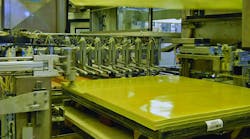PCB Materials Pave the Way to Faster, Higher-Frequency Circuits
This article is part of our IMS2022 coverage.
Designers looking to trim losses, size, and weight from high-speed, high-frequency printed-circuit boards (PCBs) will want to visit Isola Group in Booth #5090 at IMS2022. There, the company will display an array of its advanced circuit materials, which are formulated for low loss in RF/microwave and mmWave circuits to 110 GHz and beyond, as well as high levels of signal integrity in high-speed-digital (HSD) circuits well into the Gb/s speed range.
Isola’s circuit materials support the current industry trends in higher-frequency operation and miniaturization, but they do so while paying close attention to manufacturing requirements, with materials that can be transformed into PCBs using the same processes used for many popular circuit materials, such as mid-and-high-Tg FR-4 materials.
For example, Astra MT77 features low loss through mmWave frequencies, with characteristics such as dielectric constant (Dk) and dimensions that are stable over wide temperature ranges, making this an ideal circuit material for automotive and military radar applications. It exhibits a Dk of 3.00 at 10 GHz with a dissipation factor (Df) of 0.0017 at 10 GHz denoting extremely low loss. For digital circuits, Tachyon 100G laminates and prepregs support speeds to 100 Gb/s and higher. They have characteristics closely matched to Astra MT77, with Dk of 3.02 at 10 GHz and Df of 0.0021 at 10 GHz. The coefficient of thermal expansion (CTE)—how the materials’ dimensions change with temperature—is also similar across operating temperatures from -55 to +125°C, making these materials well matched for hybrid material blends in PCB assemblies for HSD and microwave/mmWave circuits.
Another circuit material well matched to Astra MT77 in CTE, I-Tera MT40 (RF/MW), has a slightly higher Dk, 3.45 at 10 GHz, but also with very low loss, signified by a Df of 0.0031 at 10 GHz. Both have the qualities needed for many emerging mmWave circuit applications, such as in automotive radar collision-avoidance systems and in 5G wireless communications networks. And both materials are FR-4 process compatible for ease of circuit fabrication.
For more information, visit the company website.
For more IMS2022 coverage, visit our digital magazine.

